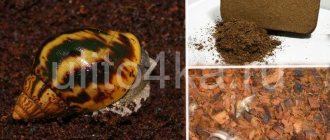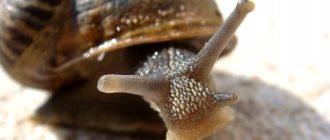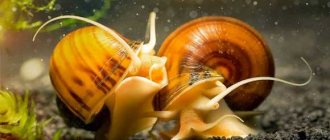How do snails die?
A dead snail does not respond to warm water and does not come out of the shell. In addition, dark-colored liquid may leak. The body becomes yellow. It gets very tough. After a couple of days, an unpleasant odor may appear.
Dead snail does not respond to warm water and does not come out of the shell
A dead individual is dealt with as follows:
- Buried in the ground.
- Throw it in the trash.
- They process the shell and leave it as a souvenir.
Most often, the corpses are simply thrown away. If you plan to keep the shell as a souvenir, you can boil the shellfish in salt water and then remove the body. Can be placed in the freezer for up to 3 days, after placing the shellfish in a bag.
My pet is dying, what should I do?
You can understand how a snail dies by its behavior and appearance. The mollusk becomes smaller in size, does not leave the shell, and does not respond to stimuli. These signs indicate a disease. It's not always possible to save your pet, but you can try.
You can understand how a snail dies by its behavior and appearance.
The snail is moved separately from other individuals. You need to lure the snail out of its shell. To do this, use warm water. The sick individual is placed in a container with warm water for 5-10 minutes. If the attempts are successful, you should offer food. If all is in vain, it is recommended to put the pet in a container of milk.
How long do they live?
Life expectancy depends on the type of mollusk and the conditions in which it is kept.
Life expectancy in natural conditions and in an aquarium is practically the same
In nature, each snail has its own time limit:
- Achatina - 7.5-10 years.
- Grape - up to 8 years.
- Ampoules - up to 4 years.
- Coils, physes, melania - from 2 to 4 years.
- Helena - 2 years old.
- Neritines – 1.5 years.
Life expectancy in natural conditions and in an aquarium is practically the same. If favorable conditions are created, the mollusks will live long enough. It was recorded that one of the grape snails lived for 30 years. It often happens that the pet dies much earlier. There are many reasons for this.
How to tell if a snail is dead
How to understand that a snail is dead is a point of interest to every aquarist. Death occurs within 2-3 days. If the mollusk is on the bottom and does not show activity, then this does not indicate death. This indicates stress. Or the pet is resting, being at rest.
A dead snail in an aquarium looks completely different than a land snail
You can tell if a snail has died as follows:
- It’s worth taking it out and inspecting the sink. If the mollusk is unhappy and alive, it will retract the body.
- A living specimen does not emit an unpleasant odor.
- Living individuals are able to move at night.
A dead pet will not meet these points. If you have any doubts and you can’t look into the shell, you should evaluate the smell. There should be a smell of rotten fish and rot.
A dead snail in an aquarium looks completely different from a land snail. At the moment of death, part of the body and a special lid that serves as a shutter hang from the shell. The decomposition process begins quickly. This leads to water spoilage. It is necessary to promptly remove corpses from the aquarium. If an empty shell is found, it is worth searching for the body.
General provisions
Most snails in captivity do not live long, since their life expectancy depends on the conditions of detention, diet and diseases suffered by them. The land snail Achatina, the most common domestic gastropod, for example, begins to age at about 4-5 years. The shell of the mollusk turns white, appetite and general activity deteriorate. All this is often accompanied by various diseases, which can cause the death of a gastropod.
It is not always possible to detect a diseased snail in advance and begin treatment. There are often situations in which yesterday the mollusk was active and healthy, but today it has gone beyond the turn and shows no signs of life. Such cases are very rare and are mostly caused by genetic diseases.
In other cases, snail owners see the suffering of their pets, but cannot do anything. The pet dies within a few days, or even weeks. If all else fails, it would be more humane to help it die so that the animal does not suffer, by placing the sick mollusk in the freezer.
Why do snails die
There are many reasons why snails die. Among them:
- age of the mollusk;
- unfavorable conditions for detention have been created;
- use of inappropriate food of poor quality;
- the emergence of infectious diseases;
- genetic feature;
- the death occurred due to the fault of the owner (errors were made in care and maintenance);
- unsuitable water composition and temperature conditions;
- neighbors are chosen incorrectly. There are predatory fish in the aquarium.
It is important to understand not only why, but also how snails die. If you recognize the signs of death right away, you can prevent your pet from leaving soon. But provided that it was not age that led to this.
Lifespan
The lifespan of each type of mollusk is different. If you create unfavorable conditions for maintenance, the lifespan is significantly reduced. In an aquarium or terrarium, gastropods live on average up to 3-4 years.
Snail old age
African species can live up to 13 years. However, at home they die much faster. The sink loses its attractiveness. It begins to gradually fade. Many breeders call this phenomenon gray hair.
The lifespan of each type of mollusk is different
As you get older, your appetite decreases. Mollusks begin to eat less and stay more at rest. This is caused by a deficiency of enzymes and a violation of the intestinal microflora. The shellfish are starting to lose weight. They are practically invisible, as they are in shells. All these are signs of approaching old age.
Age
Under natural conditions, some species can live up to 10 years. However, at home they may die earlier. Achatina is considered old when it reaches 4 years of age. Externally, old age is manifested by a white coating on the shell. The shell loses pigments. It may appear as if it has faded from exposure to direct sunlight. The older the land mollusk, the lighter its shell. Some advise lubricating the shell with special products. Unfortunately this is not practical. The snails won't look any better. They will remain “gray-haired”.
Achatina is considered old when it reaches 4 years of age
Behavioral changes are added to the appearance. Lost appetite. Pets are increasingly in rest mode – they stop moving. Gastropods decrease in size, move beyond the coil, and spend more and more time in the shell.
It is not recommended to change the conditions of detention for a dying snail. Also, you should not introduce new neighbors. You should try to disturb her less. A little stress leads to inevitable death. Solid foods are replaced by purees and juices. If the clam loses its appetite, its face is lubricated with a small amount of puree.
Incorrect conditions of detention
Life expectancy directly depends on the conditions created.
Death may occur:
- Sudden temperature changes.
- Hypothermia.
- Severe overheating.
- Incorrect soil selection.
It is recommended to remember that the mollusk is a delicate creature
This causes stress. All snails react differently to stressful situations. Some close in the shell, others hibernate. It is recommended to remember that the mollusk is a delicate creature. At low temperatures, mollusks go into hibernation, from which they do not always emerge. The soil should be chosen correctly. Be sure to process before use. A dead snail primarily indicates improper living conditions.
Inappropriate or poor quality food
Unsuitable food and low quality products are another reason leading to death. Many vegetables and fruits that reach the shelves are pre-treated with pesticides. Such products have a negative impact on the health and life of pets. Vegetables, fruits and herbs are provided exclusively in season. This approach will prevent the purchase of low-quality products. In addition, you should use only vegetables approved for feeding.
Diseases and infections
Gastropods, like many other living beings, tend to be susceptible to diseases. Most often, infections appear due to improper care and maintenance.
It is worth noting:
- poisoning;
- the process of swelling of the body, legs;
- internal or genital organs begin to fall out;
- receiving chemical and thermal burns.
Gastropods, like many other living beings, are prone to diseases
If you provide timely assistance, it will not be difficult to extend the life of a snail. In specialized stores you can find all the necessary drugs.
Genetic predisposition
If there is a genetic predisposition, it is impossible to help the snail. If this happens, the best thing to do is to act humanely. Namely, to freeze an individual that has an illness that led to the death of its ancestors.
Owner's fault
There are often cases when the blame lies entirely on the shoulders of the owner:
- the snail was dropped, which led to cracks in the shell;
- an aquarium or terrarium without a lid - the shell broke when the snail fell;
- land gastropods can easily drown while swimming;
- when tearing the mollusk away from the wall of the aquarium, force was applied, as a result of which the body fell out of the shell;
- overfeeding with foods high in protein;
- quarantine is not observed;
- the soil is poorly washed, salts and fertilizers are present;
- Greenhouse vegetables containing chemicals are used for nutrition.
the snail was dropped, which led to cracks in the shell
If you follow all the rules of care, gastropods will live a long time.
Useful qualities
Let's start with the positive qualities of this colorful mollusk. Ampoules, due to their unusual color, can serve as a kind of decorative element in your aquarium. They look very beautiful and unusual in the aquarium, ideally complementing the habitat of domestic fish. Another advantage of these snails is that they do not require special care.
Since ampullaria are snails, they do an excellent job of cleaning glass. They will regularly crawl along the inside of the glass, thereby cleaning its surface from various contaminants.
In addition, this type of snail feeds on leftover fish food - this is another plus.
Thanks to the good appetite of these bright mollusks, food residues will not accumulate at the bottom of the aquarium, and the water will not become polluted.
If one of the fish in the aquarium dies for some reason, the ampularia will eat the already dead fish. This will prevent the fish corpse from decomposing in the water, thereby poisoning it. Thus, shellfish protect living and healthy fish from toxic poisoning. It turns out that this type of snail brings great benefits by purifying the water in the aquarium and creating comfortable living conditions for the fish.
Lifespan
This giant snail is intelligent and quickly becomes a family favorite. She recognizes her owners, begs for food and takes a shower with great pleasure. Observing it has a positive effect on the human nervous system. It distracts from problems and calms you down. That’s why we become so attached to our pets and want to create optimal conditions for them.
These amazing creatures are one of the few who live longer in captivity than in nature. Their average life expectancy is 5 years, and if you are lucky, they can live all 10. Of course, everything is individual here. But in nature they have a lot of enemies, including humans. These gastropods are extremely voracious. In an aquarium, you can watch how one individual quickly destroys cucumbers and juicy lettuce leaves. And when gathered together, they can be very dangerous for fields.
Tags
die ampullaria snails in the aquarium ampullaria risesampularia snails very life ampullaria in Contents of ampullaria aquarium ampullaria they themselves ampullaria aquatic ampullaria you Yellow ampullaria absolutely Snails ampullaria snails aquarium snail. Aquarium snails ampullaria other snails. eat at aquarium slugs that snails are scavengers one snail is not Small snails hatching that snails will fall into the Aquarium For an aquarium in an aquarium, a popular aquarium snail is popular. ampularia in the aquarium Aquarium snails in the aquarium snails are kept in the aquarium, aquarium ampullaria are kept in the aquarium snails are picked out from dead ampullaria snails
algaeenough articlesmellplantsfishfemale eatreproductioninhabitantsshoulddeadunderstandknownecessarysmallerlitersshellsimplelargeresponse
Feeding
Feeding Achatina is not difficult. They know very well what is useful for them and what is not. So it is impossible to poison them. The only thing that is strictly contraindicated for Achatina is salt and spices. So you should not feed your snails salty, peppery, hot or spicy foods.
In nature, young snails feed on stems and leaves, while old snails prefer slightly rotten plants. In captivity, snails are usually fed fruits, vegetables, grass and leaves.
The size of the food should be comparable to the size of the snails. And if an adult Achatina can easily eat a cucumber core, then a small snail can suffocate by burying itself in an excessively large piece of banana.
Food should be alternated. If you constantly give only, for example, cucumbers, the snail will get used to them and refuse to eat anything else.
For a snail to grow big and beautiful, it needs calcium. The shell serves not only as protection, but also as a kind of skeleton - all the internal organs of the snail are attached to it. But there will be no beautiful and large shell with a lack of calcium. Therefore, Achatina is mixed into food or special additives, or crushed shells from raw eggs. You can even simply lay the shell on the ground - the snails will find it and eat it themselves.
Since Achatina grows all its life, they need calcium all their lives. By the way, the color of snails depends on what they eat. So the snail owner has a chance to grow his own.
No need to worry about water. Snails lick moisture from the walls of the house. That's why it's so important to spray them with water several times a day.
Causes of damage
Most often, the shell of young individuals breaks when it falls from the lid of the aquarium or under strong careless pressure from a person. In most cases, a piece of the snail breaks off from its shell. But it's not scary. In this case, the mollusk should introduce more calcium into its diet and soon the “breakage” site will be overgrown.
But the reason for a broken shell in an adult is human carelessness or poor care of the pet. In the first case, this happens when the owner drops the pet. And in the second, the snail does not receive enough necessary nutrients from food or there is no calcium in its diet. The shell of such snails is very fragile and brittle.
As for aquarium snails, the reason for the destruction of the shell is very soft water or improper placement of the mollusks in the aquarium, as a result of which they are injured.
Necessary conditions for successful reproduction
Ampularia are considered very unpretentious snails, but in unfavorable conditions they will not reproduce.
Feeding
- all food for fish, but it is most convenient to offer them food for catfish, since it sinks to the bottom, from where it will be convenient for the mollusks to pick it up;
- aquarium plants, especially if there is a lack of spirulina in their diet;
- love vegetables very much;
- they eat up the remaining organic matter from the walls and bottom of the aquarium;
- eat the corpses of dead fish.
Important! If the snails live in the same aquarium with fish, and you feed all the inhabitants with the same food, the snails may well starve: they will get too little food.
When it comes to vegetables, keep the following in mind:
- vegetables that snails cannot scrape with their mouths, for example, cabbage or bell peppers, need to be lightly boiled, but they can easily eat soft vegetables like zucchini or cucumber raw;
- the remains of uneaten vegetables should be removed from the aquarium, otherwise the water will become rotten and become unsuitable for life.
Find out what types of aquarium snails there are.
Water
The gap between the water level and the edge of the aquarium is at least 10 centimeters, and the aquarium must be covered with a fairly heavy lid, preferably glass, so that the females, in search of a convenient place for laying, do not fall out and die.
Did you know? Snails are much smarter than you might think. Due to the fact that their brain is made up of four sections, they are able to carry out thought processes and make decisions based on life experiences.
Regular filtration of water and saturation with oxygen is also required, at least twice a day for 15 minutes.
The water parameters can be anything - any water except sea water is suitable for ampularia. The only condition is that it should not be too soft, otherwise your snails’ shell will begin to deteriorate and become damaged.
Common Breeder Mistakes
Why can the Achatina snail die? Inexperienced owners themselves do not understand that by wrong actions they have caused irreparable harm to their Achatina. A few common mistakes made by breeders:
- African babies are often given to children and they love to hold them. To do this, they pull the Achatina by the shell and tear it off the surface, but this is absolutely not the way to treat the snail’s fragile legs. The muscle that holds the shell is injured by the traction, and the snail may lose its protective shell. And without a shell, the snail dies.
Advice! To tear the Achatina from a smooth surface, you need to wet it, and then place your fingers under the snail’s leg!
- If the terrariums are left without lids, then the snails strive to escape into the wild. Due to oversight by breeders, large Achatina crawl out of the container and fall onto hard surfaces. In this case, they are likely to risk damage to the shell, which is why the Achatina snail often dies. A caring owner can save a pet by treating the damaged shell and strengthening the snail’s diet with calcium-containing foods.
- Inexperienced breeders can drown their pet while swimming. If the snail is bathed under a tap, then you should not expose the snail’s head to a strong stream of water; Achatina may choke and die.
If the bathing procedure is carried out through a spray bottle in thin streams, then this is the safest.
- The delicate bodies of African Achatina are very sensitive to temperatures. From direct sunlight or the proximity of heating radiators, delicate creatures can cook, and from low temperatures in the container, from drafts from the window, they can go into hibernation and not wake up.
- A few grains of salt accidentally falling into a terrarium can kill an entire family of snails. Children unknowingly feed their pets bread, sausage, and pickles; this is a common cause of death for the Achatina snail.
Any food from the human table is detrimental to delicate snails!
- Inexperienced breeders add oranges and tangerines to the diet of sensitive African girls. Please note that citrus fruits can be given to shellfish in limited quantities. Strong acid from natural juices destroys the fragile shells of African beauties - Achatina.
Particular attention should be paid to newborn snails.here
Milk baths
How can you tell if a snail is dead? Try to buy her. Achatina loves to take a bath. If, having felt the water, the pet begins to stretch its neck and show its pleasure, then everything is fine with it. Perhaps the change in behavior is due to the onset of autumn.
But you can swim not only in water. Milk is not digested by the snail's body and leads to prolapse of internal organs. However, swimming in it works wonders. The snail quickly comes to life, it develops an appetite and increases activity.











